OPOD - A day of halos, Greenland
OPOD - A Day of Halos, Greenland: A Spectacular Display of Atmospheric Optics
Have you ever witnessed a mesmerizing display of atmospheric optics? Imagine being at Summit Station, the highest point of the Greenland Ice Cap, and witnessing a day filled with ever-changing halos. This remarkable phenomenon was captured by photographer Ed Stockard on May 8th, 2012. In this article, we will delve into the fascinating world of halos and explore the intricate details of these ethereal atmospheric displays.
Sunwards Halos: Unveiling the Familiar and the Uncommon
Looking towards the sun, Stockard's images reveal a breathtaking array of halos. The most prominent halo is the colorful outer halo known as the supralateral arc. This halo is formed by horizontal column crystals and is a common sight in the sky. However, what makes this particular supralateral arc even more intriguing are the brightenings on it, which are possibly rare Parry supralateral arcs. These Parry supralateral arcs are not commonly observed in their raw natural form and are often seen in artificial ski-slope snow machine displays.
As we further explore the sunwards halos, those with a practiced eye might also discern traces of helic arcs. Helic arcs add another layer of complexity to the halo display, contributing to its overall beauty. Witnessing these unique halos in their natural form is truly a rarity, making Stockard's photographs even more remarkable.
Opposite the Sun: A Kaleidoscope of Halo Phenomena
When the sky puts on a show, it's always worth looking in the opposite direction of the sun. Two hours after capturing the sunwards halos, Stockard turned his gaze away from the sun and was greeted with an astonishing sight. The same parhelic circle that crossed the sky opposite the sun was still visible. In addition, there was a bright anthelion, a point where several halo arcs intersect. This anthelion exhibited rare Tricker and diffuse arcs that curved upwards and downwards from it.
The Wegener arcs, which originated from the tangent arc, slanted down towards the anthelion, adding to the intricate web of halo phenomena. The simulation provided below aids in identifying these various halo arcs, allowing us to appreciate the complexity and beauty of their interplay.
The Enigmatic Anthelion: A Crossroads of Halo Arcs
The anthelion, unlike distinct ray path halos, is not a single halo but a convergence point for multiple halo arcs. Its upward "Y" shape is a composite of diffuse arcs and Tricker arcs, both of which are exceptionally rare. These unique halo arcs are formed by the tortuous path of light through horizontal column crystals.
Below the parhelic circle, the Tricker and diffuse arcs merge into an anthelic column of whiteness. This diffuse glow contrasts starkly with the manmade orange hues present in the surroundings. The juxtaposition of natural and artificial colors adds an extra layer of intrigue to the overall spectacle.
The Ever-Changing Parhelic Circle
Throughout the day, Stockard's photographs reveal the parhelic circle circling the sky, constantly changing as successive swarms of diamond dust crystals swept across. This phenomenon adds a dynamic element to the atmospheric display, capturing the transient nature of halos and reminding us of their fleeting beauty.
Conclusion
Witnessing a day filled with halos in Greenland's pristine icy landscape is a truly awe-inspiring experience. Stockard's photographs provide us with a glimpse into the intricate world of atmospheric optics, showcasing the familiar and the rare in stunning detail. From supralateral arcs to Tricker and diffuse arcs, each halo adds to the symphony of light in the sky.
As we marvel at these natural phenomena, let us remember the delicate interplay between light and ice crystals that creates such captivating displays. The ever-changing nature of halos reminds us of the fleeting beauty that surrounds us in the natural world. So, the next time you find yourself under a clear sky, take a moment to look up and appreciate the wonders of atmospheric optics that may be unfolding right before your eyes.
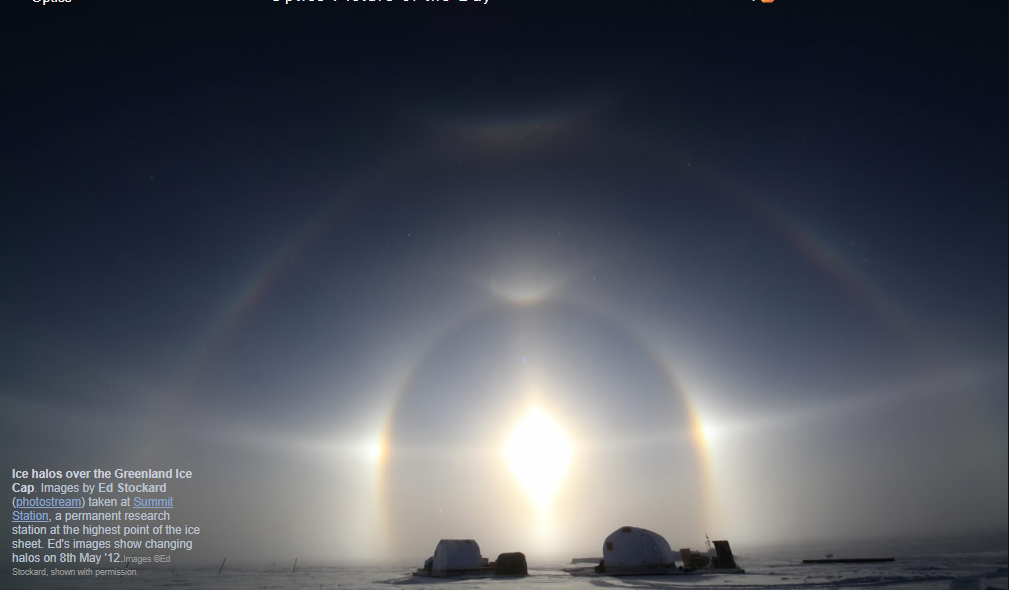
Ice halos over the Greenland Ice Cap. Images by Ed Stockard (photostream) taken at Summit Station, a permanent research station at the highest point of the ice sheet. Ed's images show changing halos on 8th May '12.Images ©Ed Stockard, shown with permission.
Top: Sunwards showing familiar and none too familiar halos. The colourful outer halo is a supralateral arc from horizontal column crystals. The brightenings on it are possibly rare Parry supralateral arcs. The practiced eye might also see traces of helic arcs. These two halo are now often seen in 'artificial' ski-slope snow machine displays but are rare in raw nature.
Lower: Always look in the opposite direction when the sky puts on a show. Ed was looking directly away from the sun two hours after the topmost image. The same parhelic circle crosses the sky. Opposite the sun there is a bright anthelion. Rare Tricker and diffuse arcs curve upwards and downwards from it. Wegener arcs that have crossed the sky from the tangent arc slant down towards the anthelion. See the simulation below for identification.
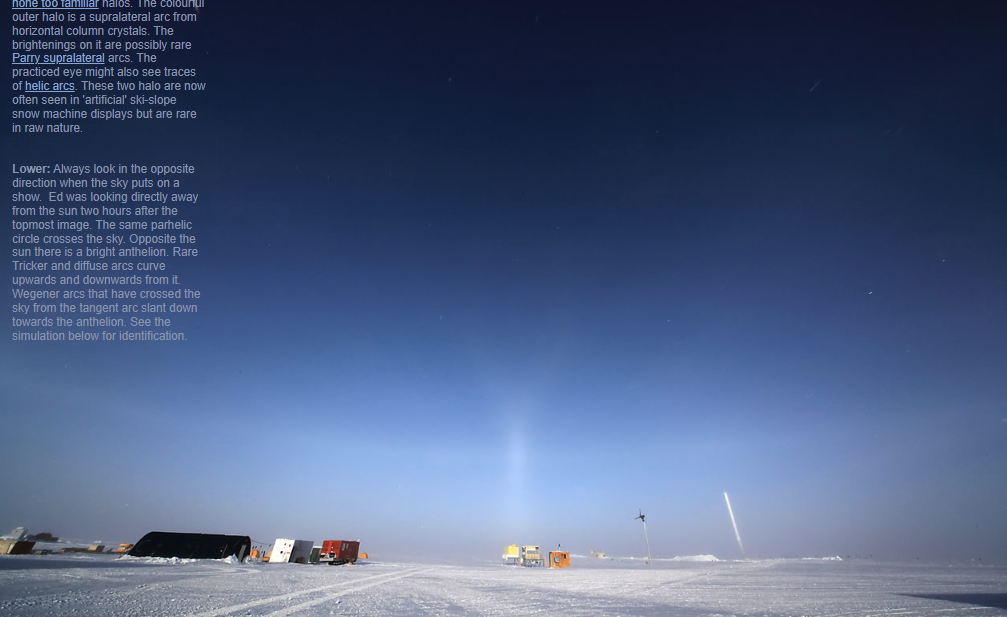
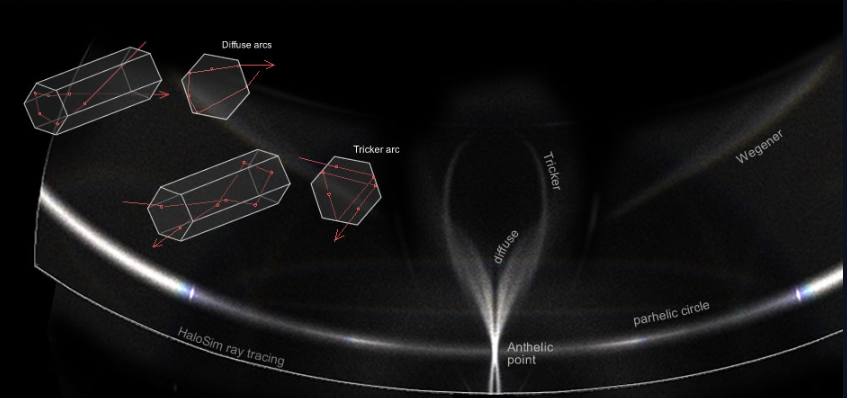
A HaloSim ray tracing simulation of the anthelic region.
The parhelic circle is relatively weak opposite the sun.
The 'anthelion' is not a halo with distinct ray paths. rather, it is where several halo arcs cross. The upwards "Y" shape is a composite of 'diffuse arcs' and Tricker arcs. Both are rare. Both are produced by tortuous ray paths through horizontal column crystals.
Below the parhelic circle, the Tricker and diffuse arcs are close together, column like, and finally merge at the antisolar point below the horizon.
Below: Another hour onwards, the diffuse whiteness of the anthelic column of Tricker and diffuse arcs contrasts with manmade orange.
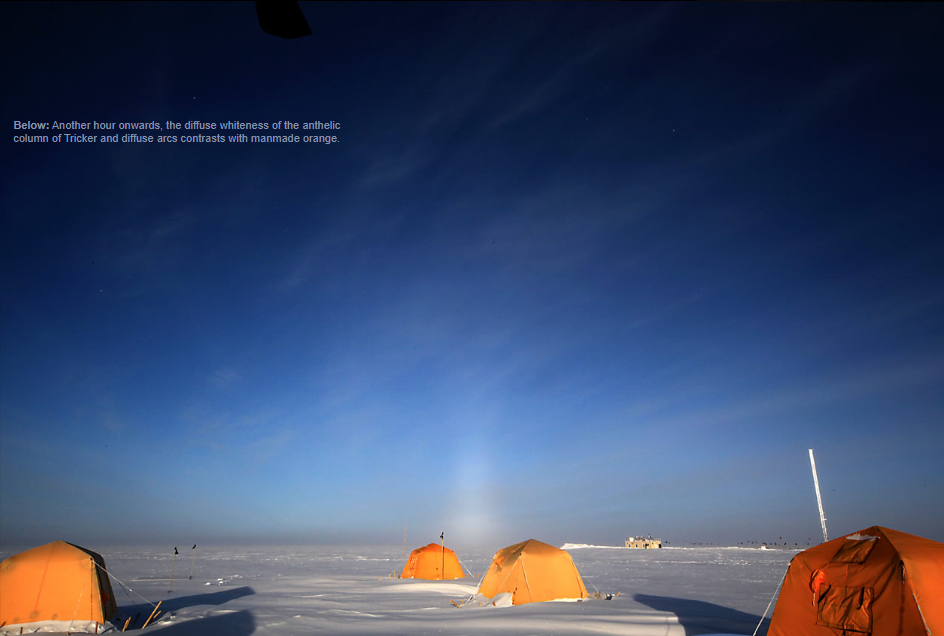
Earlier in the day. A parhelic circle circled the sky, changing as successive swarms of diamond dust crystals swept across.
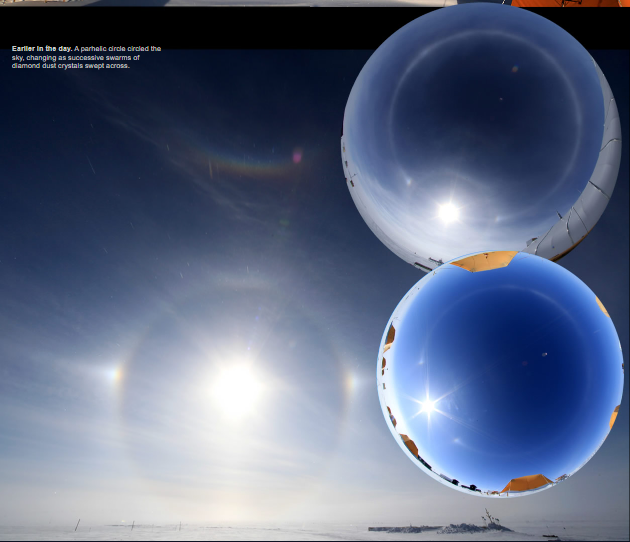
Note: this article has been automatically converted from the old site and may not appear as intended. You can find the original article here.
Reference Atmospheric Optics
If you use any of the definitions, information, or data presented on Atmospheric Optics, please copy the link or reference below to properly credit us as the reference source. Thank you!
-
<a href="https://atoptics.co.uk/blog/opod-a-day-of-halos-greenland/">OPOD - A day of halos, Greenland</a>
-
"OPOD - A day of halos, Greenland". Atmospheric Optics. Accessed on April 16, 2024. https://atoptics.co.uk/blog/opod-a-day-of-halos-greenland/.
-
"OPOD - A day of halos, Greenland". Atmospheric Optics, https://atoptics.co.uk/blog/opod-a-day-of-halos-greenland/. Accessed 16 April, 2024
-
OPOD - A day of halos, Greenland. Atmospheric Optics. Retrieved from https://atoptics.co.uk/blog/opod-a-day-of-halos-greenland/.